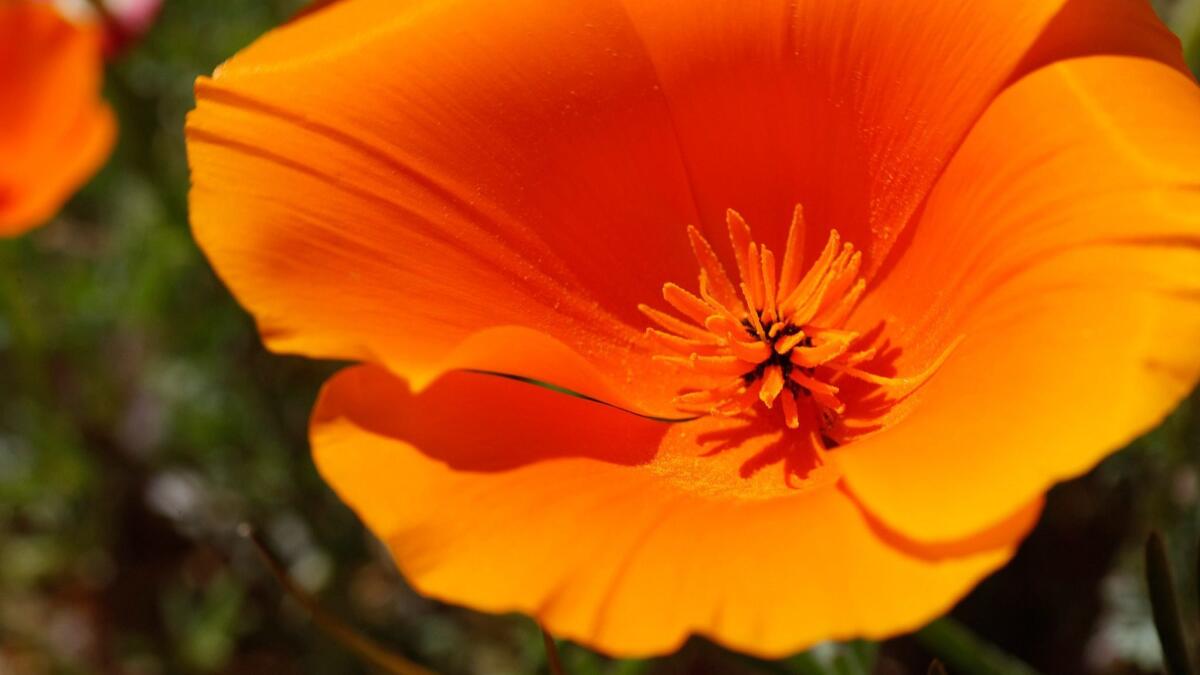Think recent rains can revive wildflower season in California’s deserts? Wrong. Here’s why--and why you may need to look to the mountains

- Share via
What a difference a year makes. Last March, bright orange California poppies carpeted the hills of the Antelope Valley California Poppy Reserve in Lancaster. This year, a few plants are just starting to bloom.
“We are estimating a small to moderate poppy bloom in about another week or two if the nice weather holds and if we do not get too much frost or heat,” the reserve posted Monday on Facebook.
I know what you’re thinking: We just had rain. Didn’t that help? The answer is: not enough. It’s just too late in the season for new poppy plants to germinate; they needed the rain in December and January to get started.
Desert wildflowers have the same problem.
Anza-Borrego Desert State Park, which in 2017 had the best wildflower blooms in 20 years, described this year’s bloom as “limited.” The park near Borrego Springs, Calif., received just an inch of rain this year, compared with 6.6 inches last year.
Joshua Tree and Death Valley national parks east of L.A. aren’t expecting showy blooms. It doesn’t mean this isn’t a beautiful time to visit California’s deserts, you just need to adjust your expectations of what you’ll see. Maybe this is the year to go to see stars in the night sky instead of flowers.
Wildflower lovers may need to look to the mountains this year instead. Late season blooms could pop in the Santa Monica Mountains after what has been a confusing winter season for plants, whose seeds rely on a sensitive balance of temperature, water and sunlight.
“The recent rains that we’ve had are encouraging,” Joey Algiers, a National Park Service restoration ecologist, said in a statement. “What was looking like a bad year for wildflowers could turn around, potentially peaking in mid- to late April.”
That’s promising news for a season that started out too warm, then turned dry, then cold, and then brought frost and heavy rains, Algiers said. A bit of prickly phlox, currants and bush lupine have started to bloom.
Keep your eye on places such as Malibu Creek State Park in Calabasas, the China Flat area of Cheeseboro Canyon in Ventura County and Rancho Sierra Vista in Newbury Park, the last two in the Santa Monica Mountains National Recreation Area.
Back at the poppy reserve, despite the lack of last year’s profuse poppies, other plants are coming up along the trails, such as grape soda lupine, fiddleneck and filaree.
State park interpreter Jean Rhyne offers the slimmest of hopes for more poppies to pop.
“However, we did have a March Miracle a couple decades ago,” she wrote in an email. “Are the conditions right for another one this year? We won’t know until happens …”
Twitter: @latimestravel
ALSO
It’s all about the cool water on a warm-weather escape to Arizona’s Rim Country
Check out movie history on a weekend escape to Kanab, Utah, a.k.a. Little Hollywood
Discover dry Owens Lake on a weekend escape to Lone Pine
More to Read
Sign up for The Wild
We’ll help you find the best places to hike, bike and run, as well as the perfect silent spots for meditation and yoga.
You may occasionally receive promotional content from the Los Angeles Times.






